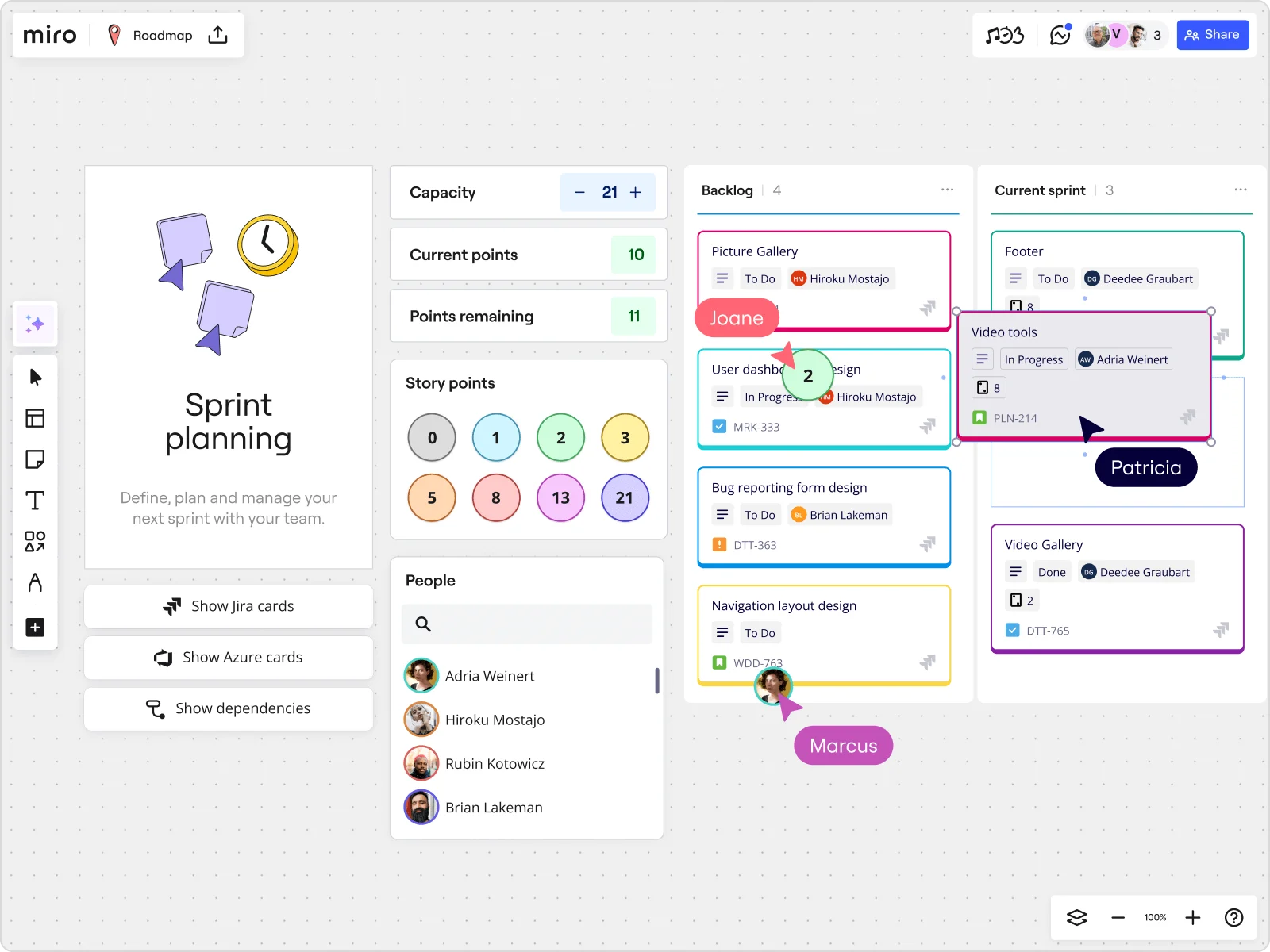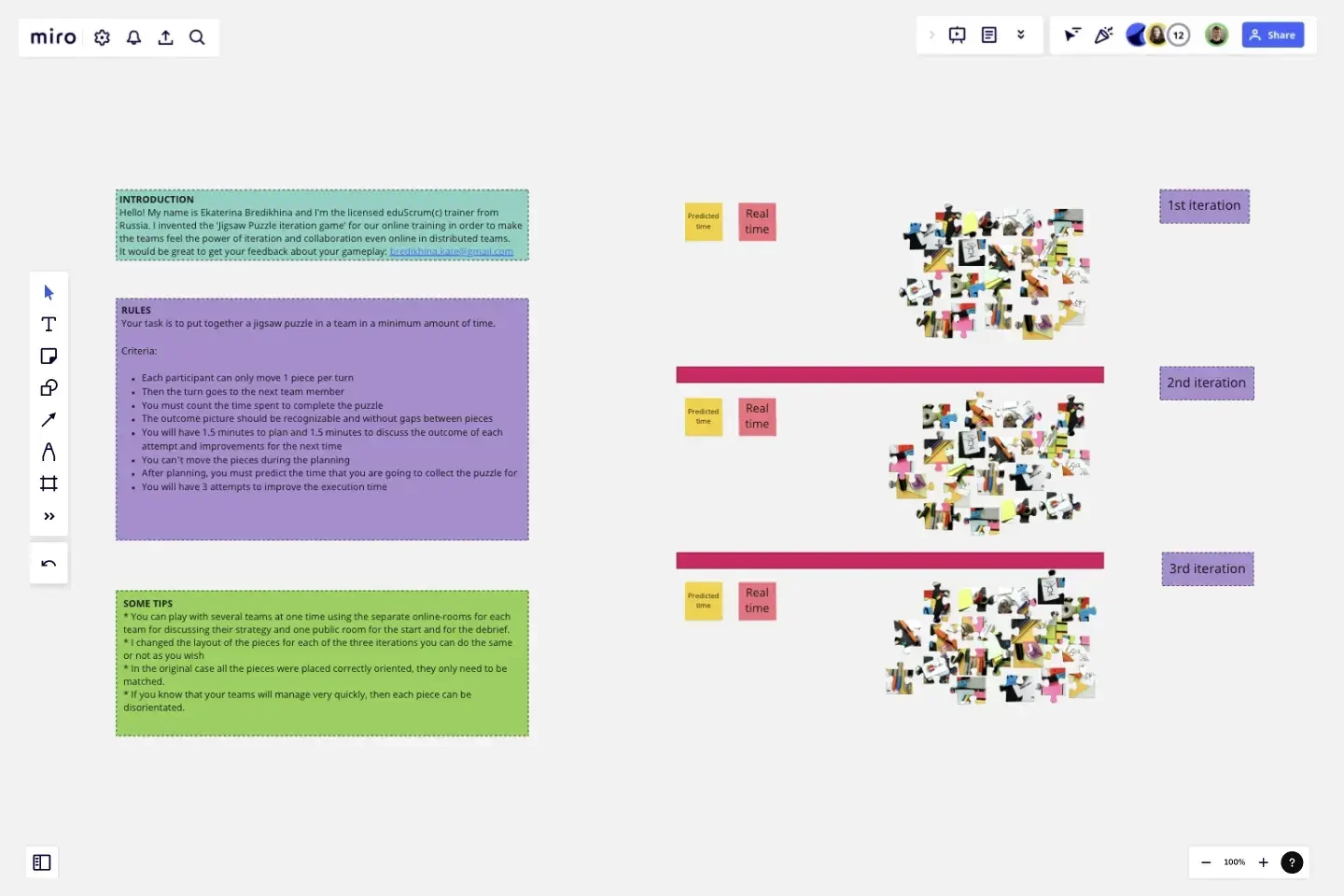
Table of contents
Table of contents
How to run a good scrum meeting?

Summary
In this guide, you will learn:
- Structure and timebox Scrum meetings for efficiency
- Miro tools for Scrum ceremonies (daily stand-ups, retrospectives, sprint planning)
- Encourage team engagement in Scrum meetings
- Integrate Scrum boards with project management tools
- Monitor meeting progress and align with sprint goals
- Best practices for co-located and remote Scrum meetings
Try Miro now
Join thousands of teams using Miro to do their best work yet.
Scrum meetings are the heartbeat of agile project management. When done right, they can supercharge your team's productivity and collaboration.
Designed to keep teams aligned and projects on track. These meetings are short, focused, and highly collaborative, ensuring everyone knows what’s happening and what needs to be done next. The primary goal is to foster transparency, inspection, and adaptation within the team.
But how do you run a good scrum meeting? Let's dive into the essentials.
Different types of scrum meetings you need to know
Scrum isn’t just about daily stand-ups. There are several types of scrum meetings, each with its unique purpose:
- Daily stand-ups: These are quick, daily check-ins, usually lasting 15 minutes, where team members answer three key questions: What did I do yesterday? What will I do today? Are there any impediments in my way? This keeps everyone informed and helps identify issues early.
- Sprint planning: This meeting kicks off the sprint. The team discusses what can be delivered in the upcoming sprint and how they will achieve it. The Product Owner presents the prioritized backlog, and the team selects items they can commit to completing.
- Sprint review: At the end of the sprint, the team demonstrates the work completed to stakeholders. This meeting is an opportunity for feedback and ensures the product is evolving in the right direction.
- Sprint retrospective: This is a reflective meeting where the team discusses what went well, what didn’t, and how processes can be improved. It’s a crucial part of continuous improvement in Scrum.
Key principles for effective scrum meetings
Effective scrum meetings hinge on a few key principles:
- Time-boxing: Each meeting has a fixed duration. This ensures that discussions remain focused and efficient. For example, daily stand-ups should not exceed 15 minutes.
- Focus: Keep discussions relevant to the sprint goals. Avoid going off on tangents that don’t contribute to the immediate objectives.
- Collaboration: Encourage open communication and active participation from all team members. This fosters a sense of shared purpose and collective ownership of the project.
To keep your meetings on track, start by starting on time. Respecting everyone’s time by adhering to the scheduled start and end times sets a professional tone and ensures that the meeting runs smoothly.
Next, stick to the agenda. Having a clear agenda and following it closely helps avoid deviations from the planned topics. If new issues arise, note them down and address them later, either in a separate meeting or offline. This practice keeps the meeting focused and efficient.
Encouraging participation is also key. Use techniques like round-robin to ensure everyone has a voice. This not only helps in uncovering hidden issues but also fosters a collaborative environment where everyone feels involved and responsible for the project’s success.
Finally, foster open communication. Create a safe space where team members feel comfortable sharing their thoughts and concerns. When team members trust that their input is valued and respected, they are more likely to contribute meaningfully, leading to more effective problem-solving and innovation.
Preparing for a scrum meeting like a pro
Preparation is half the battle. Here are some tips:
- Set a clear agenda: Outline the topics to be covered and stick to it. This helps keep the meeting focused and efficient.
- Invite the right participants: Ensure that all necessary team members are present. This typically includes the Scrum Master, Product Owner, and Development Team.
- Gather necessary materials: Have all relevant documents, reports, and tools ready. For example, use Miro’s innovation workspace to visualize the sprint backlog and progress.
Good questions to ask during scrum meetings
Asking the right daily questions can make a world of difference. Here are some good questions to ask during scrum meetings:
- Daily Stand-ups: What did you accomplish yesterday? What are you planning to do today? Are there any obstacles in your way?
- Sprint Planning: What are the most critical tasks for this sprint? Do we have all the information needed to start these tasks?
- Sprint Review: What feedback do we have from stakeholders? How can we incorporate this feedback into our next sprint?
- Sprint Retrospective: What went well during this sprint? What didn’t go as planned? How can we improve our processes for the next sprint?
These questions help keep the team focused and identify potential roadblocks early.
Roles and responsibilities in scrum meetings
Understanding the distinct roles and responsibilities within a scrum team is crucial for the success of scrum meetings. Each role has specific duties that contribute to the overall effectiveness and productivity of the team.

Scrum Master: The Scrum Master plays a pivotal role in facilitating the meeting. They ensure that the meeting stays on track and adheres to the time-boxed schedule. The Scrum Master is also responsible for removing any impediments that the team faces, enabling them to focus on their tasks without unnecessary distractions. By fostering an environment of open communication and collaboration, the Scrum Master helps the team maintain momentum and stay aligned with their goals.
Product Owner: The Product Owner is the voice of the stakeholders and is responsible for providing clarity on priorities. They ensure that the team is working on the most valuable tasks that align with the overall project objectives. During scrum meetings, the Product Owner communicates the vision and goals, answers questions, and provides feedback. Their role is crucial in guiding the team’s efforts towards delivering maximum value to the stakeholders.
Development Team: The Development Team is at the core of the scrum process. They are responsible for discussing progress, sharing updates, and identifying any obstacles that might hinder their work. The team collaborates to find solutions to these challenges and ensures that they are on track to meet the sprint goals. Each member of the Development Team contributes their expertise and skills to deliver the product increment by the end of the sprint.
Common challenges in scrum meetings
Scrum meetings aren’t without their challenges, but with the right strategies and tools, you can address these issues effectively. Here’s how to tackle some common problems using Miro’s features:
Distractions: Distractions can derail even the best-planned meetings. To minimize interruptions, set clear ground rules such as asking team members to silence their phones and close unrelated tabs on their computers. Miro’s innovation workspace can help by providing a focused, visual environment where all necessary information is centralized. Use Miro’s digital whiteboards to keep everyone engaged and visually aligned, reducing the temptation to multitask.
Lack of Participation: Encouraging quieter team members to share their thoughts can be challenging. Use direct questions to engage them and create an inclusive atmosphere. Miro’s collaboration features, such as anonymous voting and sticky notes, allow everyone to contribute ideas without the pressure of speaking up in front of the group. This can help uncover valuable insights from all team members, fostering a more inclusive and participatory meeting.
Poor Time Management: Managing time effectively is crucial for productive scrum meetings. Use a timer to keep track of the meeting duration and ensure discussions stay within the allotted time. Miro’s built-in timer feature can help you monitor the time spent on each agenda item, keeping the meeting on track. If discussions are running long, Miro’s ability to create breakout boards allows you to take detailed conversations offline or schedule a separate meeting, ensuring the main meeting remains focused and efficient.
By leveraging Miro’s robust features, you can overcome these common challenges and run more effective scrum meetings. Miro’s innovation workspace supports real-time and asynchronous collaboration, helping your team stay aligned and productive.
Tools and resources for effective scrum meetings
The right tools can transform your scrum meetings. Miro’s online scrum board offers robust collaboration features, supporting both real-time and async work. Our AI-powered visual canvas makes it easy to visualize tasks and progress, ensuring everyone stays aligned. Integrate your board with other useful tools like Jira, Asana, and Confluence for seamless collaboration.
To help you get started, here goes a few Scrum templates that can help you create your next amazing scrum meeting:
Basic daily stand-up meeting template
Keep focused on your quick daily check-in meeting with the Daily Stand-up Meeting template. Help your team work together more effectively.

Scrum compass retrospective
The Scrum Compass retrospective cards are based on the Scrum Guide. The primary purpose of the Scrum Compass is to help Scrum practitioners apply Scrum principles properly. Cards are used to educate people who want or already use Scrum to make products or provide services.

Roadmap planning template
The roadmap planning template in Miro is a powerful tool designed to streamline the process of planning and tracking project milestones. This template also integrates AI, interactive widgets, and automation to enhance productivity. It is customizable and scalable, making it suitable for various team needs, from product development to marketing campaigns.

Scrum Puzzle iteration game
The 'Jigsaw Puzzle iteration game' template helps to make the teams feel the power of iteration and collaboration even online in distributed teams.

Sprint planning and review templates
Define, plan, and manage your next sprint using the Sprint Planning with Jira template. Or optimize workflows and collect valuable feedback with Miro's 50+ retrospective templates collection. Reduce the time needed to synthesize and distribute findings after a retro and move straight into executing new strategies.
Ready to elevate your scrum meetings? Try Miro today and experience the difference a good scrum meeting can make.
Author: Miro Team
Last update: October 14, 2025